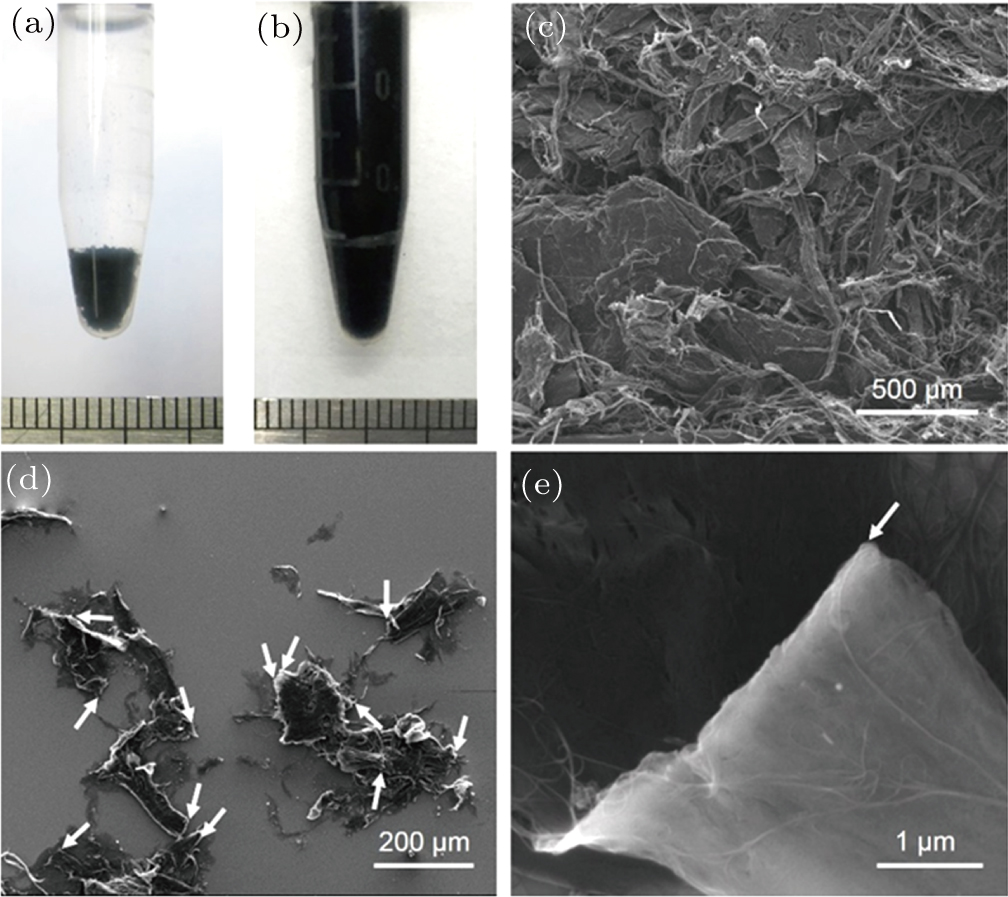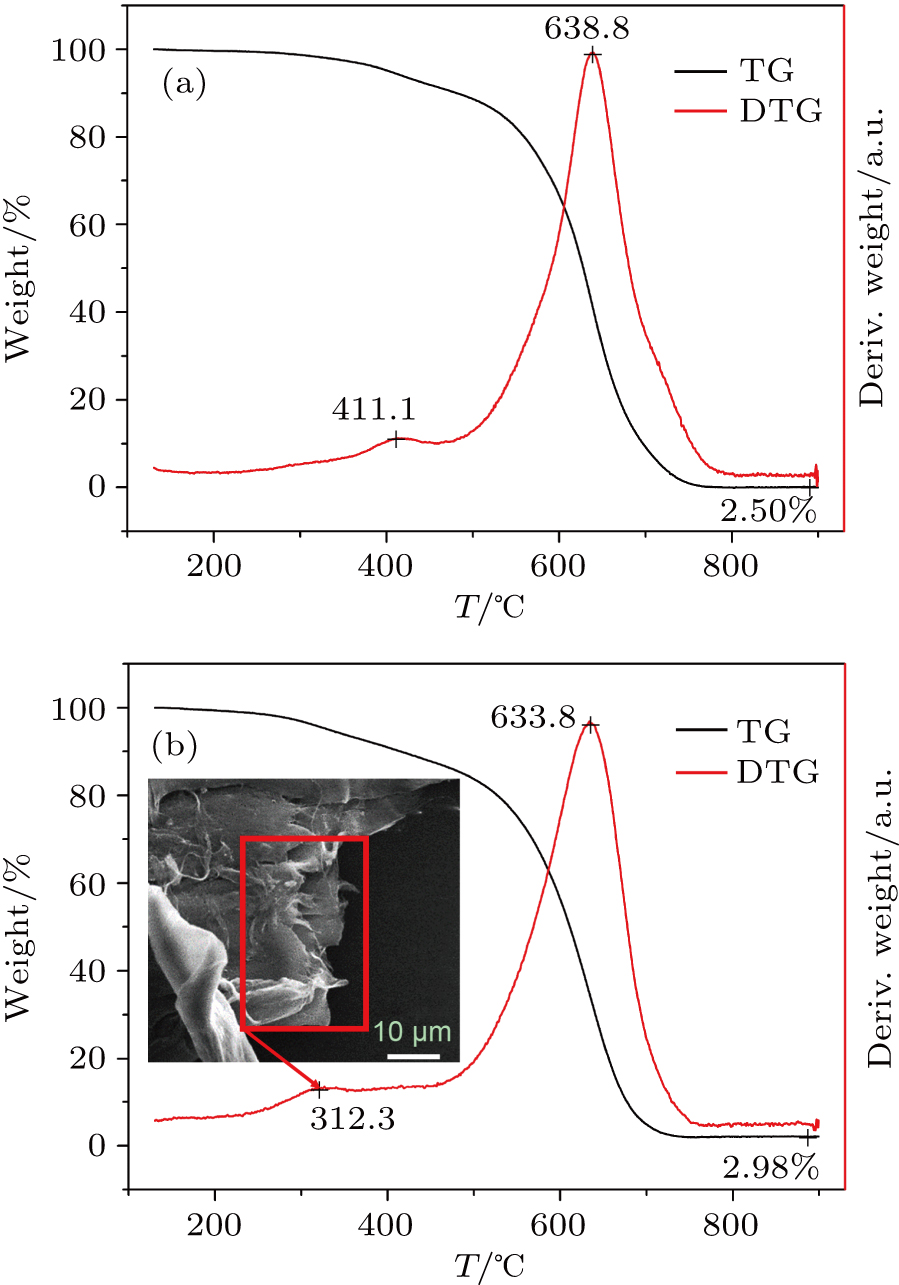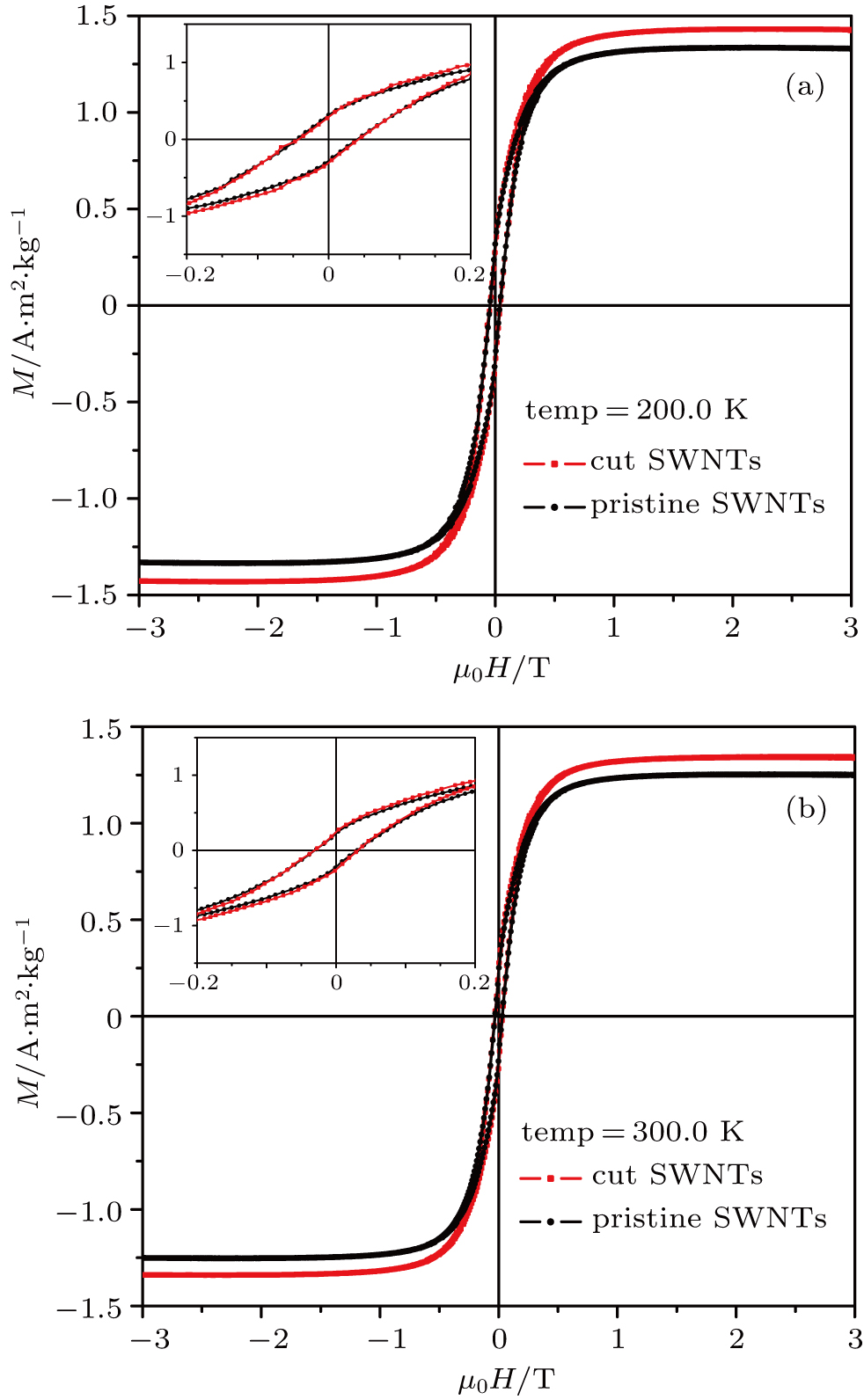† Corresponding author. E-mail:
Project supported by the National Key Research and Development Program of China (Grant Nos. 2018YFA0208403 and 2016YFA0200403), the National Natural Science Foundation of China (Grant Nos. 51472057, 11874129, 91323304, and 11674387), the Strategic Priority Research Program of the Chinese Academy of Sciences (Grant No. XDA09040101), and the Baotou Rare Earth Research and Development Centre, Chinese Academy of Sciences (Grant No. GZR 2018001).
In this work we report that after single-walled carbon nanotubes (SWNTs) are sheared with a pair of titanium scissors, the magnetization becomes larger than that of the corresponding pristine ones. The magnetization increases proportionally with the number of SWNTs with sheared ends, suggesting that there exist magnetic moments at the sheared ends of SWNTs. By using the coefficient of this linear relation, the average magnetic moment is estimated to be 41.5 ± 9.8 μB (Bohr magneton) per carbon atom in the edge state at temperature of 300.0 K, suggesting that ultrahigh magnetic fields can be produced. The dangling sigma and pi bonds of the carbon atoms at sheared ends play important roles in determining the unexpectedly high magnetic moments, which may have great potential applications.
Ultrahigh magnetic fields play an important role in condensed matter physics,[1–7] chemistry,[8] materials science,[9,10] and biosciences.[11,12] In the laboratory, they are usually produced by very large currents flowing through superconducting, resistive or hybrid magnets, which requires the extreme conditions (low temperature, huge cooling water and tens of megawatts of power) and thus restricting their applications.[13] As a matter of fact, magnetic fields can also be produced with magnetic materials,[14,15] which have the advantages of higher working temperature and low energy consumption. However, the highest previously reported magnetic field produced with magnetic materials was about 2.5 Tesla, which is much lower than ultrahigh magnetic fields usually needed.[1–12] In this work, we report that single-walled carbon nanotubes (SWNTs) start to oxidize at 312 °C in dry air after they are sheared. This oxidation temperature is much lower than that of amorphous carbon (∼411 °C) and that of pristine SWNTs (∼633 °C). Meanwhile, by measuring the magnetizations of pristine SWNTs samples, the corresponding treated ones and the percentage of SWNTs with sheared ends in the SWNTs samples, the magnetic moments at the sheared ends of SWNTs are quantified using SQUID and PPMS. At a temperature of 300.0 K, if edge states with a width of 1 nm are formed due to relaxation and reconstruction at the sheared ends of SWNTs, then the average magnetic moment is estimated to be 41.5 ± 9.8 μB per carbon atom in the edge states, suggesting that ultrahigh magnetic field can be produced. The dangling sigma and pi bonds of carbon atoms at the sheared edges of SWNTs play important roles in determining the unexpectedly high magnetic moments and ultrahigh magnetic fields.
The SWNTs used in this work were grown by floating catalytic chemical vapor deposition and were supplied by Chengdu Organic Chemicals Co. Ltd., Chinese Academy of Sciences. The SWNTs appeared as black powers in bulk with a high weight purity of about 97.5%, the diameter and length of individual SWNTs of about 1.5 nm∼ 2.0 nm and 20 ± 5 μm, respectively (see Supplementary Material, Fig. S1(1). The individual SWNTs usually form bundles with quite a wide distribution in diameter and length as seen from SEM images (Fig.
After shearing treatment, the lengths of SWNT bundles are still longer than those of their component individual SWNTs (∼ 20 μm) (Fig.
These results indicate that after experiencing the shearing treatment, the SWNTs in the SWNT sample can be classified into two types: SWNTs unaffected and SWNTs sheared successfully. For SWNTs that are successfully sheared, there are sheared ends in SWNTs. For these SWNTs with sheared ends, the carbon atoms at the edge sites have only two neighboring carbon atoms,[18] in contrast to other carbon atoms that bond to three neighboring carbon atoms. The dangling bonds (sigma and pi) of the carbon atoms at the edges may result in some new, novel properties. As shown later, the oxidation of the SWNTs with sheared ends starts at temperature as low as 312 °C, by which the percentage of SWNTs that have been sheared in the shear-treated SWNT sample can be estimated.
Typical results of thermo–gravimetric (TG) analysis and differential thermo–gravimetric (DTG) analysis of purified, pristine SWNT samples are shown in Fig.
After experiencing the shearing treatment, the curves of TG and DTG of SWNT samples show the following interesting characteristics (Fig.
| Table 1. Data of 6 pristine SWNT samples and corresponding sheared ones, from which magnetic moment at sheared ends of SWNTs are obtained. Temperature: 300.0 K; External field: 3.0 T. M0: saturated magnetization of pristine SWNT samples. Superscripts (“α” and “β”) represent that data are obtained with “PPMS-9” (“α”) and “SQUID-VSM” (“β”), respectively. When both appear, it indicates that magnetization is measured with both facilities. M1: saturated magnetization of corresponding sheared SWNT samples. ΔM: M1–M0. SWNTs with sheared ends (%): percentage of SWNTs with sheared ends after being treated, which is obtained with corresponding DTG curve. Average ΔM: linear fit of the ΔM of the samples (S1–S6). Average magnetic moment: average increased magnetic moment of each carbon atom of SWNTs in the sheared SWNTs when percentage of SWNTs with sheared ends in SWNT sample is 100%.. . |
The excess amorphous carbon may be produced at the sheared ends of SWNTs, and may cause the burning that starts at 312.3 °C. However, this explanation of the burning can be excluded due to the following reasons: first, the weight percentages at which the burning starts at 312.3 °C is in the range of 1.8% to 6.5% in the sheared samples. And this weight percentage is in the same magnitude to that of the amorphous carbon (∼ 8%). Second, it is well-known that amorphous carbon is usually present at the outer walls of nanotubes. Since nanotubes have much larger length than diameter, this suggests that if the burning that starts at 312.3 °C comes from excess amorphous carbon that may be produced at the sheared ends, the excess amorphous carbon should have much higher density and can be easily observed using TEM. As shown in the Supplementary Material, Fig. S4-2, no such amorphous carbon is found.
Therefore, by comparing the TG and DTG curves of a sheared SWNTs sample with those of pristine SWNT sample, the percentage of SWNTs with sheared ends in the sheared sample can be estimated. For pristine SWNT samples, the ratio between amorphous carbon and SWNTs is calculated by using the area of the corresponding peaks in DTG curve. This ratio varies a little from sample to sample. Four pristine SWNT samples are tested and their amorphous carbons have the weight percentages of 8.02%, 8.94%, 9.56%, and 7.58%, respectively. The average value of 8.53% is used in the following calculations. For sheared SWNT samples, the percentage of amorphous carbon and SWNTs with sheared ends can be obtained by calculating the areas in DTG curve (Fig.
These results indicate that the dangling sigma and pi bonds of carbon atoms at edges are more chemically reactive, resulting in lower oxidation temperature in dry air. Meanwhile, the sheared ends of SWNTs provide unique defect structures, which are ideal for the study of defects-caused ferromagnetism; as reported previously in graphene[22–27] and MWNTs.[28] Therefore, the following experiments are carried out to measure quantitatively the magnetic moment at the sheared ends of SWNTs.
After the weight of a pristine SWNT sample is measured, the sample is immersed into ethanol and transferred into a sample holder, while the same holder is used for a physical property measurement system (Quantum Design, PPMS9) and a superconducting quantum interference device (Quantum Design, SQUID VSM). The magnetization curves of the SWNT sample are measured by using a vibrating sample magnetometer with a sensitivity of 10−9 A·m2 (PPMS9) or 10−11 A·m2 (SQUID VSM), which utilizes Faraday’s Law to measure the magnetic moment of the sample. After being measured, the SWNT sample is transferred into a centrifuge tube for shearing treatment. After being sheared, the SWNTs sample with some amount of ethanol is transferred back into the sample holder for measurement.
Typical curves of magnetizations (M) against applied field for a pristine (black) and its corresponding sheared (red) SWNTs are shown in Fig.
These curves of magnetizations of pristine (black) and sheared (red) SWNTs samples indicate clearly that there are ferromagnetism and magnetic moment in these samples. For pristine, purified SWNTs samples, although the weight purities of these SWNTs samples are all as high as 97.5%, there is still trace amount of iron and/or iron oxide (Supplementary Material, Fig. S4-1). Due to the small content of these phases, it is quite difficult and challenging to implement a quantitative analysis of these phases. This makes the quantitative analysis of the magnetizations of pristine SWNTs samples quite difficult. The very small differences among the residual mass of pristine samples (∼ 0.01%) suggest that the content and ratios of iron and iron oxide are quite uniform among pristine samples. The values of magnetization (M) of pristine SWNTs samples vary quite a lot from sample to sample, as shown in Table
Another quite interesting and important result from Fig.
Table
It should be noted that the magnitudes of magnetic moments at the sheared ends of SWNTs are different from those reported previously at the open ends of MWNTs.[28] The possible reasons may be as follows. First, the samples are different. In Ref. [28], MWNTs are used rather than SWNTs as reported in this work. This may suggest that the diameter and hence curve of nanotubes may have effects on the magnetic moment. Second, in Ref. [28], the magnetic moment is obtained indirectly, which is calculated from the deflection of a cantilever of a bundle MWNT, while in this work the magnetic moments at the sheared ends of SWNTs are obtained directly by using PPMS and SQUID, which are the most sensitive equipment for measuring magnetic signals. Third, it is not clear whether the magnetic moment depends on the atomic end and/or nanotube structure since the SWNTs in this work are a mixture of SWNTs with different diameters and chiralities, which deserves more theoretical and experimental studies.[32–34]
In this work, we show that SWNTs can be successfully sheared along a direction perpendicular to the axis of SWNTs by using a pair of titanium scissors. The oxidation of SWNTs with sheared ends starts at a temperature as low as 312 °C in dry air. At a temperature of 300.0 K, if edge states with a width of 1 nm are formed, the average magnetic moment is 41.5 ± 9.8 μB per carbon atom in the edge states, suggesting that ultrahigh magnetic fields can be produced at the sheared ends of SWNTs. Producing a ultrahigh magnetic field by using the SWNTs has the advantages of a higher working temperature and low energy consumption, implying their great potential applications.
| [1] | |
| [2] | |
| [3] | |
| [4] | |
| [5] | |
| [6] | |
| [7] | |
| [8] | |
| [9] | |
| [10] | |
| [11] | |
| [12] | |
| [13] | |
| [14] | |
| [15] | |
| [16] | |
| [17] | |
| [18] | |
| [19] | |
| [20] | |
| [21] | |
| [22] | |
| [23] | |
| [24] | |
| [25] | |
| [26] | |
| [27] | |
| [28] | |
| [29] | |
| [30] | |
| [31] | |
| [32] | |
| [33] | |
| [34] |




